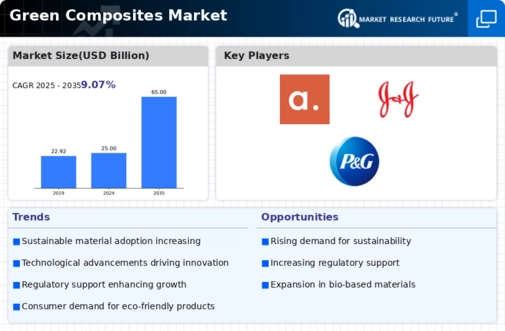Top Industry Leaders in the Green Composites Market
 These eco-friendly materials, made from natural fibers and bio-based resins, are reshaping industries, from construction and automotive to marine and consumer goods. But beneath the verdant surface lies a competitive landscape as vibrant as the rainforest, where established giants and innovative startups battle for market share.
These eco-friendly materials, made from natural fibers and bio-based resins, are reshaping industries, from construction and automotive to marine and consumer goods. But beneath the verdant surface lies a competitive landscape as vibrant as the rainforest, where established giants and innovative startups battle for market share.
Strategies Sprouting Success:
-
Product Diversification: Companies like Evonik, BASF, and UPM Biocomposites are branching out, developing bio-based composites with tailored properties for specific applications. Think flax fibers for lightweight car panels and hemp fibers for durable building materials.
-
Vertical Integration: Securing a steady supply of natural fibers is crucial. Some players, like Trex Company, are investing in fiber plantation partnerships and processing facilities to gain control over the supply chain and optimize costs.
-
Sustainability Focus: The "green" in Green Composites isn't just a marketing term. Companies are adopting responsible sourcing practices, using renewable energy sources in production, and developing fully compostable or recyclable bio-composites to minimize environmental impact.
-
Geographical Expansion: Emerging economies in Asia and Africa present fertile ground for growth. Companies like China Jushi Group and Tecnaro are establishing production facilities and forging partnerships in these regions to capitalize on the rising demand for sustainable construction materials.
Factors Rooting Market Share:
-
Environmental Regulations: Governments worldwide are tightening regulations on carbon emissions and promoting the use of eco-friendly materials. This provides a significant advantage for Green Composites over traditional composites. -
Cost Competitiveness: While initial costs of Green Composites might be higher, their lower lifecycle costs due to improved durability and recyclability are making them increasingly attractive. -
Technological Advancements: Research and development efforts are leading to more efficient production processes, improved fiber treatments, and novel bio-resin formulations, further enhancing the performance and affordability of Green Composites. -
Consumer Awareness: Growing environmental consciousness is translating into increased consumer demand for sustainable products. Companies that effectively communicate the eco-friendly benefits of Green Composites gain a competitive edge.
Key Players:
Key players of the global green composites are
- Flex Form Technologies (U.S.)
- TECNARO GMBH (Germany)
- Procotex SA Corporation NV (Belgium)
- Green Gran BN (The Netherlands)
- UPM Biocomposites (Germany)
- MCG Biocomposites LLC. (U.S.)
- ALPAS srl (Italy)
Recent Developments
-
September 2023: A major wildfire in Indonesia disrupts the supply of natural fibers, temporarily impacting production and prices of Green Composites. -
October 2023: A consortium of leading research institutions and industry players launches a collaborative project to develop new bio-based resins with high fire resistance, expanding the application potential of Green Composites. -
November 2023: BASF unveils a fully compostable bio-composite specifically designed for agricultural mulch films, addressing the issue of plastic waste in farming. -
December 2023: The Green Composites market exhibits signs of continued growth, with increasing investments in production capacity and a strengthening pipeline of innovative applications across various industries.









